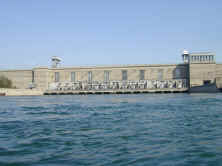Click here for Russian version of this page.
Construction of Irkutsk Hydroelectric Power Station - located at the Angarskogo cascade - began in the spring of 1950. At the time it was one of the largest structures in the country. The project required constructing a dam more than two kilometers in length, including a Hydroelectric Power Station building that was was 240 meters in length, and within which were mounted eight units with a total generating capacity of 660 thousand watts.
 The Hydroelectric Power Station had to be constructed in a seismic zone, so
gravel and sand were chosen as building materials for the dam. These materials
compact and become stronger when shaken by ground movement. The dam was designed
to be especially robust and stable, capable of withstanding a water column forty-two
meters high; it would raise the level of the Angara up to that of Lake Baikal
and then raise the level of the lake itself one and a half meters. Such bulky
dams were not widely-known in world practice at the time.
The Hydroelectric Power Station had to be constructed in a seismic zone, so
gravel and sand were chosen as building materials for the dam. These materials
compact and become stronger when shaken by ground movement. The dam was designed
to be especially robust and stable, capable of withstanding a water column forty-two
meters high; it would raise the level of the Angara up to that of Lake Baikal
and then raise the level of the lake itself one and a half meters. Such bulky
dams were not widely-known in world practice at the time.
The steel-reinforced concrete foundation of the Hydroelectric Power Station had to built in the depths of the river bottom. To reliably protect this construction, a huge foundation ditch had to be dug that would tie into the firm rocky base, and a powerful waterway had to be created within it. It was necessary to build water channels to pass water through the Power Station building, to block the Angara, to prepare ditches for water basins from the dam up to Baikal, to relocate the people living in the area to be flooded, and to demolish all the structures.
At the end of August, 1956, with the construction deadline approaching, it became necessary for a fleet of large dump-trucks to haul in no less than 900 thousand cubic meters of ground fill in two months. The pressure head retention of the water basin depended on it.
Finally, on 29 December, 1956, at 19:00, the first power generating unit was switched on. The Irkutsk dam became the first in the Angaro-Eniseisk cascade of dams, which is the central core of The United Energy System of Siberia.
The Irkutsk Hydroelectric Power Station was not the only major construction project going on at the time. A food oil factory, the first precast concrete factory in the city, an ice factory and an ice cream factory were being built, along with railroad tracks connecting the factories to the Trans-Siberian. Educational facilities and hostels for the Polytechnical Institute were also being built, and construction began on Akademogorodok, the "Science City" of the Siberian branch of the Academy of Sciences.
In 1957 more than 30 sq. m. of residential housing was built. In 1958-1960, a neighborhood of multi-story brick houses was constructed in the area around 2ya Zheleznodorozhnaya and Botkina streets where there were many barracks that had housed the builders of the first Angara bridge.
In 1960 construction of a tram route from the station to the Polytechnical Institute was begun. Krugobaikalskaya, Chaikovskogo, Mayakovskogo, Gogolya, Profsoyuznaya, Irkutnaya streets and others were asphalted and equipped with modern conveniences. Lermontova street appeared, followed by the erection of the Children's park and a garden of the Parisian commune, in that order.
Julia SLOBODCHIKOVA.
 By preparation of a material N.F.Salatskogo's book About the past, how it
was. Irkutsk. 1992
By preparation of a material N.F.Salatskogo's book About the past, how it
was. Irkutsk. 1992